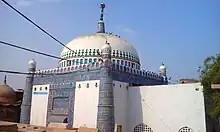
The Tomb of Khawaja Awais Kagha is a prominent Sufi mausoleum of Multan[1] located in Dera Basti cemetery, 1.6 kilometers southwest of Multan's historical center in Pakistan.[2][3]
It was constructed around 1300 AD.[2]
Architecture
The tomb's architecture, echoing the 10th-century Ismail Samani Mausoleum in Bukhara, consists of a square base with corner turrets and a dome.[2]
The tomb's exterior is adorned with blue and white glazed tiles, a distinctive Indus Valley feature originating from early Multan tombs.[2] The building's main axis is atypical, facing south, while Islamic tradition usually favors east-facing entrances.[2] This orientation is suggestive of Suhrawardi Sufi tombs in Multan, representing a departure from Islamic norms in favor of multifaith traditions.[2] However, the tomb maintains orthodoxy through its southwest-aligned qibla, allowing prayers directed towards Mecca.[2]
References
- ↑ Sultanate Period Architecture: Proceedings of the Seminar on the Sultanate Period Architecture in Pakistan, Held in Lahore, November 1990. Anjuman Mimaran. 1991.
- 1 2 3 4 5 6 7 "Khawaja Awais Kagha Tomb, Multan, Pakistan". Asian Architecture. Archived from the original on 2023-05-20. Retrieved 2023-05-20.
- ↑ Malik, Amjad (August 30, 2019). "ملتان میں حضرت خواجہ اویس کا قدیم مقبرہ". Samaa TV. Archived from the original on May 20, 2023. Retrieved May 20, 2023.